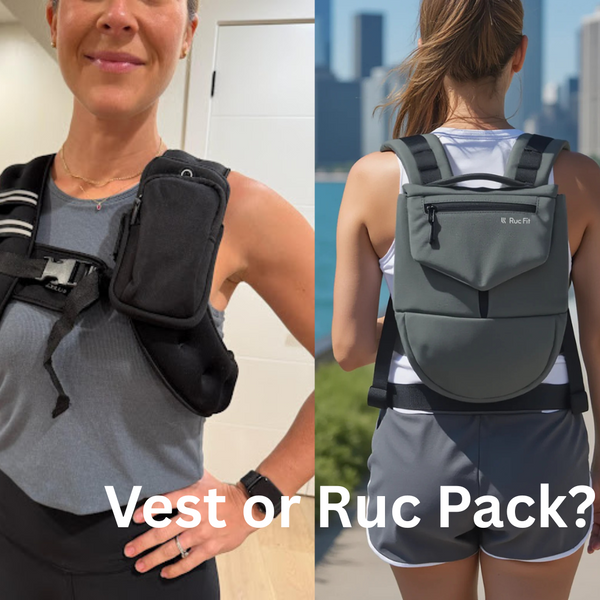
Weighted Vest vs. Ruck Pack: Which is Better for Rucking?
Rucking is one of the most straightforward ways to build strength and endurance: just load up and walk. But the method of carrying that load can significantly influence performance, comfort, and long-term progress. The two most common options–weighted vests and ruck packs–each bring distinct pros and cons.
While vests are often praised for their compact fit, ruck packs offer greater versatility, better ergonomics, and a more scalable approach to training. Here’s how they compare across key factors.
-
Breathing and Heat Management
Weighted vests sit across the chest, which can subtly restrict breathing and trap heat–especially during warm weather or longer efforts. Even moderate weight on the front of the torso can reduce ventilation and cause discomfort as the body works harder to cool down.
Ruck packs, in contrast, leave the chest free and unobstructed. Because the weight is positioned on the upper back, airflow remains open and body heat can dissipate more naturally. For those rucking in warmer climates or covering longer distances, the difference in breathability can translate to noticeably better endurance.
-
Load Capacity and Progression
Most weighted vests max out at around 20 to 45 pounds. They’re sufficient for general conditioning or short-duration workouts, but less adaptable for progressive overload–especially for those training up to higher weights over time.
Ruck packs typically offer greater load flexibility. Purpose-built models often include internal sleeves to stack multiple standard-weight plates, making them ideal for progressive training. This kind of versatility allows users to gradually increase resistance as their strength improves, without being locked into a fixed weight system.
-
Weight Distribution and Muscle Engagement
Vests distribute weight evenly across the front and back of the torso, which can feel balanced initially–but all of that load is carried by the shoulders. Over time, especially with heavier weights, this can lead to significant fatigue in the traps and upper back.
Ruck packs shift the load primarily to the back, closer to the body’s natural center of gravity. When designed well, they distribute weight evenly across the shoulders and upper back, with the option to transfer load to the hips through a supportive belt. This distribution not only enhances comfort, but also promotes better posture and increased core engagement throughout the movement.
-
Long-Term Comfort and Mobility
The tight, compressive fit of a vest can make it feel secure–but also restrictive. It limits natural torso rotation and, for some body types, can become uncomfortable over time.
Ruck packs generally allow for more natural movement. Ergonomic designs–like those with high-riding, contoured frames–move with the body rather than against it. Padded shoulder straps, adjustable sternum support, and removable waist belts all contribute to a smoother experience during longer sessions or varied terrain.
-
Sweat, Chafing, and Seasonable Suitability
Vests wrap snugly around the body, which can quickly lead to overheating and sweat buildup. This is useful in cold weather, but in warmer conditions it tends to reduce comfort and increase the likelihood of chafing.
Backpacks, especially those with breathable back panels and minimal surface area contact, help reduce heat buildup. In transitional seasons and summer months, this often makes rucking backpacks the more comfortable and sustainable option, whereas vests are better suited to colder weather rucks.
-
Versatility for Everyday Movement
Vests excel in short workouts or bodyweight training, where minimal bounce and close contact are key. They’re useful for specific activities like Murph prep or indoor circuits.
Rucking packs, however, adapt more easily to a variety of real-life scenarios. Whether you’re walking your dog, commuting on foot, or hiking local trails, a compact, ergonomically designed pack blends well into daily life. Packs that mimic the shape and look of a regular backpack–while still holding significant weight–add functional strength training to everyday routines without drawing attention.
The Bottom Line
Vests are useful for:
- Short workouts
- Static or bodyweight exercises
- Cold-weather training
- Highly stable loads
Rucking packs are ideal for:
- Longer rucks and hikes
- Progressive strength training
- Better posture and breathing
- Everyday wear and movement
For most rucking purposes–especially those focused on building endurance, strength, or conditioning over time–a backpack provides better ergonomics, increased scalability, and a more balanced experience.
Packs specifically built for rucking often sit high on the back, include weight plate sleeves, and offer features like padded straps and removable hip belts for added comfort and control.
Models like the Ruc Pack combine these details in a compact, durable form that supports both performance and daily use. Whether you’re out for a long walk or integrating resistance into everyday movement, choosing the right load-carrying method can elevate the entire experience–and your results.